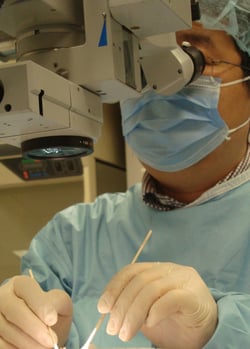A Researcher’s Life during COVID-19: Part 2
As one of Transonic’s application specialists, I very much enjoy working together with my former academic colleagues in all stages of their life sciences careers. Over the past year, I have had the pleasure to start collaborating with two researchers; Dr. Pedro Baptista, a well established scientist in his field of expertise and Marc van Moorsel, a young and enthusiastic PhD student trying to continue to collect data for his PhD thesis in these days of the COVID-19 pandemic.
Pedro Baptista MD PhD, Translational Research Group in Digestive Pathology, Aragon Health Science Institute, Zaragoza, Spain.
My main scientific goal is to deliver bioengineered tissues and associated biotechnologies for regenerative hepatology. It is within one of the projects associated with this goal, that I have been working with Astrid for the past year. She has been supporting us from the moment we decided that chronic blood flowprobes were a must have to make our porcine liver transplantation model a success. In the early phase of the project, she flew in to join us in the OR to help decide the configuration and sizes of the probes needed to measure both the graft and host vessels during operational procedure. From these measures we decided best blood flowprobe configuration to chronically implant in the recipient animal. Long term blood flow measurements are successful when you pay attention to details during the implantation procedure. Astrid has shared her experience with us where she can and has asked additional advice from her colleagues where possible, to assure that we would benefit from all Transonic’s know how.
 At the moment we have no experiments running in the lab, as Spain has been in full lock down to regain control over SARS-CoV-2 spread. Full lock down here means that we may only leave the house for necessary groceries, pharmacy and seek healthcare, if necessary. This has given me and my group the opportunity to write new project proposals. As COVID-19 does not seem to directly create liver problems, we have rejuvenated one of our in vitro organoid projects. The current project proposal is an international collaboration and hypotheses that populations that have an active tuberculosis vaccine program in place, are less susceptible to SARS-CoV-2 spread. As there is immediate need for clinical proof, human trials are being conducted as we speak. However, there are many confounding factors in these trials, due to population specific circumstances, genetic factors etc. Our group proposes to do proof of principle studies using the in vitro lung organoid system. This organoid system is a combination of lung epithelial cells, alveolar and interstitial macrophages and natural killer cells, which is a big advantage over ‘traditional’ tissue culture where only one cell type is studied at a time. We believe that these studies will help us to a better understanding the dynamics of SARS-CoV-2 infections and will contribute to find a solution to stop the spread of this pandemic.
At the moment we have no experiments running in the lab, as Spain has been in full lock down to regain control over SARS-CoV-2 spread. Full lock down here means that we may only leave the house for necessary groceries, pharmacy and seek healthcare, if necessary. This has given me and my group the opportunity to write new project proposals. As COVID-19 does not seem to directly create liver problems, we have rejuvenated one of our in vitro organoid projects. The current project proposal is an international collaboration and hypotheses that populations that have an active tuberculosis vaccine program in place, are less susceptible to SARS-CoV-2 spread. As there is immediate need for clinical proof, human trials are being conducted as we speak. However, there are many confounding factors in these trials, due to population specific circumstances, genetic factors etc. Our group proposes to do proof of principle studies using the in vitro lung organoid system. This organoid system is a combination of lung epithelial cells, alveolar and interstitial macrophages and natural killer cells, which is a big advantage over ‘traditional’ tissue culture where only one cell type is studied at a time. We believe that these studies will help us to a better understanding the dynamics of SARS-CoV-2 infections and will contribute to find a solution to stop the spread of this pandemic.
Marc van Moorsel, PhD candidate, Laboratory of Clinical Chemistry and Hematology, University Medical Center Utrecht, The Netherlands.
The application I’m working on is a mouse thrombosis model. For my doctoral thesis I’m hypothesizing that developing thrombi can be visualized by imaging fibrin as one of its main contributors. I test this in a mouse model where I intravenously administer fluorescent anti-fibrin antibodies followed by induction of a thrombus via FeCl3 application on the carotid artery. A decrease in blood flow is measured as a result of the developing thrombus, I subsequently investigate whether the antibodies specifically bind fibrin within the thrombus. As the blood flow measurements are in my experimental set-up a way to verify thrombus formation, it is crucial that we can reliably measure the normal carotid blood flow that is no more than 2 ml/min on average before we introduce the thrombus. Additionally, we aim to improve replicability - hence standardize the procedure - by measuring fluorescence at a fixed and stable occlusion, as determined via the flowprobe.
 My collaboration with Astrid started quite recently, just before SARS-CoV-2 forced us to slow down our daily routines. We had scheduled Astrid’s training visit to our laboratory in at the University Medical Center Utrecht, when it became apparent that Astrid was not allowed to travel anymore. As I had no experience with the TS420 Perivascular Flowmeter from Transonic and the 0.5mm Nanoprobe looked quite fragile in my hands, I was very pleased to learn that we could set-up a Skype meeting with me being in the lab and Astrid working from home. She talked me through full set-up of our equipment and I could test first functionality as if she was standing next to me in the lab. This first meeting has allowed me to start my in vivo experiments, as I’m fortunate enough to work in one of the few labs where we are allowed to reserve lab time and space according to government guidelines, allowing me to slowly continue my research, albeit individually.
My collaboration with Astrid started quite recently, just before SARS-CoV-2 forced us to slow down our daily routines. We had scheduled Astrid’s training visit to our laboratory in at the University Medical Center Utrecht, when it became apparent that Astrid was not allowed to travel anymore. As I had no experience with the TS420 Perivascular Flowmeter from Transonic and the 0.5mm Nanoprobe looked quite fragile in my hands, I was very pleased to learn that we could set-up a Skype meeting with me being in the lab and Astrid working from home. She talked me through full set-up of our equipment and I could test first functionality as if she was standing next to me in the lab. This first meeting has allowed me to start my in vivo experiments, as I’m fortunate enough to work in one of the few labs where we are allowed to reserve lab time and space according to government guidelines, allowing me to slowly continue my research, albeit individually.
Lately, I have been experiencing some challenges during my measurements that I can’t explain yet myself. As we are still not allowed to invite guests into our laboratory, a second online meeting was quickly scheduled with Astrid. She will again be guiding me through my experiment and I am confident that together we can optimize the blood flow measurements.
So no matter where you are in your life science career, Transonic’s application specialists are always here to help you move your research forward. We are looking forward to hear from you to learn how we can help.



